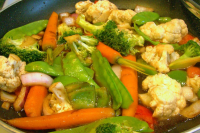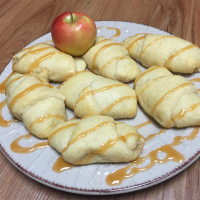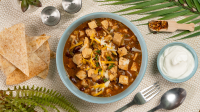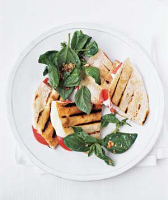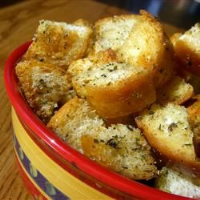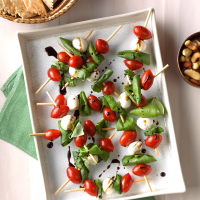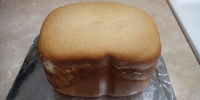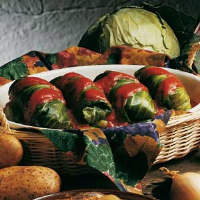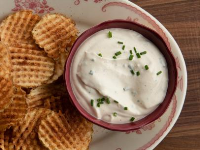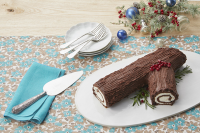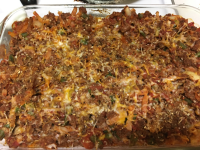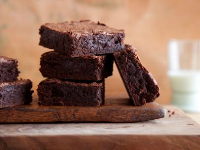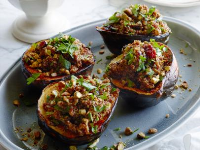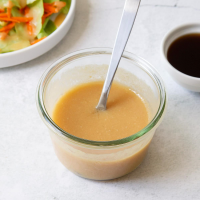CLASSIC ROAST TURKEY WITH HERBED STUFFING AND OLD ...
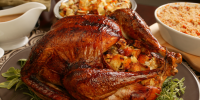
After trying every turkey-roasting method under the sun, I've finally settled on this as absolutely the best. The secret? Slow down the cooking of the breast area, which tends to get overcooked and dried out before the dark meat is done, with a cover of aluminum foil. These instructions are for a 12-pound turkey, which serves eight people. But you can easily scale it up for a bigger bird. Estimate about one pound of meat per person (one and a half pounds if you want lots of leftovers) and refer to the chart in the Test-Kitchen Tips, below, for the scaled-up cooking times.
Provided by Rick Rodgers
Yield Makes 8 servings
Number Of Ingredients 7
Steps:
- Place oven rack in lowest position and preheat oven to 325°F. Butter 8-inch square baking dish or 2-quart casserole. Lightly brush roasting rack with vegetable oil and place in roasting pan.
- Remove plastic or paper packet of giblets from turkey (usually in small cavity). Remove from packaging and rinse; reserve gizzard and heart; discard floppy, dark purple liver. Remove neck from large cavity. Remove from packaging, rinse, and reserve. Using tweezers or needlenose pliers, remove any feathers and quills still attached to skin (kosher turkeys tend to require this more than others). Pull off and reserve any visible pale yellow knobs of fat from either side of tail (not found on all birds).
- Rinse turkey inside and out with cold water and pat dry. Loosely fill small (neck) cavity with stuffing. Fold neck skin under body and fasten with metal skewer. Loosely fill large body cavity with stuffing. Transfer remaining stuffing to buttered dish and drizzle with ¼ cup stock. Cover with aluminum foil and refrigerate until ready to bake.
- Transfer turkey, breast-side up, to rack in roasting pan. Tuck wing tips under breast and tie drumsticks loosely together with kitchen string. Rub turkey all over with softened butter and sprinkle with 1 teaspoon salt and ½ teaspoon pepper. Tightly cover breast area with foil, leaving wings, thighs, and drumsticks exposed.
- Transfer gizzard, heart, neck, and reserved turkey fat to roasting pan around rack. Pour 2 cups stock into pan.
- Roast turkey 45 minutes. Baste with pan juices (lift up foil to reach breast area) and continue roasting, basting every 45 minutes, 1½ hours more (2¼ hours total). Baste again and, if pan juices have evaporated into glaze, add 1 cup stock to pan. Roast another 45 minutes (3 hours total). Remove foil from breast area, baste, and add stock if necessary, until instant-read thermometer inserted into fleshy part of thigh (close to but not touching bone) registers 180°F, about 1 hour more (4 hours total).
- Insert instant-read thermometer into center of stuffing in body cavity. If thermometer does not read 165°F, transfer stuffing to microwave-safe baking dish and microwave on high until 165°F, about 3 minutes for 10 degrees. Cover and keep warm. Using turkey holders (or by inserting large metal serving spoon into body cavity), transfer turkey to large serving platter. Let stand 30 minutes before carving.
- Meanwhile, bake extra stuffing and make gravy: Raise oven temperature to 350°F. Remove giblets and neck from roasting pan and discard. Pour pan juices into measuring cup or gravy separator. Let stand until fat rises to top, 1 to 2 minutes, then skim off and reserve fat or, if using separator, carefully pour juices into measuring cup, reserving fat left in separator.
- Transfer foil-covered dish of extra stuffing to oven and bake 10 minutes. Meanwhile, add enough remaining stock to pan juices to total 4 cups. Measure turkey fat, adding melted butter if necessary to total 6 tablespoons. Straddle roasting pan across 2 burners on moderate heat and add fat. Whisk in flour, scraping up browned bits on bottom of pan, then cook, whisking constantly, 1 minute. Whisk in pan juice–stock mixture and bring to a boil, whisking often. Reduce heat to moderately low and simmer, whisking occasionally, until gravy thickens, about 5 minutes. Whisk in remaining ¾ teaspoon salt and ½ teaspoon pepper and keep warm. (Gravy can be kept warm over very low heat, covered, up to 20 minutes. If it thickens, thin with additional stock before serving. If skin forms on top, whisk well to dissolve.)
- When extra stuffing has baked 10 minutes, remove foil and bake, uncovered, until heated through, about 10 minutes. Pour gravy through fine-mesh sieve into large bowl, then transfer to gravy boat. Carve turkey and serve gravy and stuffing alongside.
- •To combat dryness, most frozen turkeys and some fresh are injected with a saline solution. This is not a good thing, though: Injected birds generally lack flavor and can have a mushy texture. For this reason, we recommend buying a fresh turkey and checking the label to be sure there aren't any additives. (Look for the words "all natural.") Don't be too concerned, though, with the many other terms that can be applied to turkeys, such as free-range, organic, or heritage. All can be excellent.
- •When buying a fresh bird, be sure to purchase it no more than two days before Thanksgiving. If you must get a frozen bird, defrost it in the refrigerator in a pan to catch drips, allowing a full 24 hours for each 5 pounds.
- •Warm, moist stuffing is an optimal environment for bacteria such as salmonella or E. coli to multiply, so it's important to follow safe procedures. Be sure to make the stuffing at the last minute so it can go into the bird warm. This helps it move above the "danger zone" (the optimal temperature range for bacteria growth) more quickly during roasting. When you remove the turkey from the oven, be sure to check the temperature in the middle of the stuffing to make sure it's 165°F, the temperature at which bacteria will be killed. If it's not 165°F, scoop it out of the cavity and microwave it as directed in the recipe.
- •More stuffing tips: Be sure not to overpack the cavities, as the stuffing will expand during cooking. Loosely fill the turkey, then spread the extra in a casserole dish (no more than 2 inches deep) and bake it after the turkey comes out (be sure to refrigerate it until then to impede bacteria growth). Drizzle the portion in the casserole dish with extra stock to make up for the juices it won't get from the turkey. If you want the stuffing that's cooked inside the turkey to be extra-moist (as opposed to having a crisp crust where it's exposed), cover the exposed portion with a small piece of aluminum foil.
- •Opinions vary on whether or not to stuff the bird—some people think it can cause uneven cooking. If you prefer not to stuff your bird, fill the cavities with a chopped vegetable and herb mixture that will impart its flavor to the meat and pan juices: Chop 1 onion, 1 celery rib with leaves, 1 carrot, and 3 tablespoons fresh parsley. Mix this with 1 teaspoon each dried rosemary, sage, and thyme. Sprinkle the cavities with salt and freshly ground black pepper and place the mixture inside. An unstuffed bird will take about 15 minutes to a half hour less to cook than a stuffed bird. When the turkey is cooked, tilt it to allow any juices that have collected in the cavity to drain into the pan. Do not serve the vegetable mixture, as it may not have cooked to a safe temperature.
- •This recipe can easily be scaled up to serve more people. Estimate about 1 to 1½ pounds per person. Cooking times (for a stuffed bird, cooked at 325°F to an internal temperature of 180°F) will be as follows: 8 to 12 pounds: 3 to 3½ hours 12 to 14 pounds: 3½ to 4 hours 14 to 18 pounds: 4 to 4¼ hours 18 to 20 pounds: 4¼ to 4¾ hours 20 to 24 pounds: 4¾ to 5¼ hours
- •Some experts prefer to cook their turkeys to an internal temperature of 170°F (rather than 180°F, as in this recipe). If you don't mind having the meat slightly pink, this is perfectly safe and makes it more moist. However, Rick Rodgers, who created this recipe, believes that the dark meat in particular does not achieve its optimum flavor and texture until it reaches 180°F. If you choose to stuff your turkey and cook it to only 170°F, its stuffing will almost definitely not reach the safe temperature of 165°F. When you remove the turkey from the oven, be sure to check the temperature in the center of the stuffing, and if necessary remove it and microwave it as directed in the recipe.
- •Letting the turkey stand for half an hour after it comes out of the oven is an essential part of the roasting process. When meat roasts, its juices move to the outer edge of the flesh. Letting it rest gives the juices time to redistribute, making for a moister turkey. An added bonus: The resting time provides an excellent window of opportunity to make the gravy and reheat the side dishes. There's no need to cover the bird—it'll stay warm enough, and covering it would only soften the crispy skin.
MAKE-AHEAD TURKEY GRAVY RECIPE: HOW TO MAKE IT
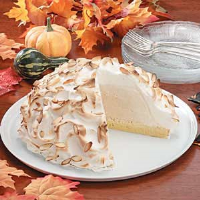
My family loves gravy, so I can never have enough of this make-ahead turkey gravy recipe on hand for a holiday dinner. The base is prepared with turkey wings and can be prepped in advance. —Linda Fitzsimmons, Fort Edward, New York
Provided by Taste of Home
Total Time 02 hours 25 minutes
Prep Time 02 hours 15 minutes
Cook Time 10 minutes
Yield 4-1/4 cups.
Number Of Ingredients 9
Steps:
- Place turkey wings and onions in a greased 13x9-in. baking pan. Bake, uncovered, at 400° for 1-1/4 hours, turning once., Transfer wings and onions to a Dutch oven. While 13x9 pan is still warm, carefully add 2 cups broth. Using a spatula, gently scrape any brown bits off bottom of pan; pour into Dutch oven with wings. Add 4 cups broth, carrots, celery and thyme to Dutch oven. Bring to a boil. Reduce heat; simmer, uncovered, about 45 minutes. , Strain; discard wings and vegetables. (Can be made ahead to this point and stored in the refrigerator for up to 2 days.) Skim fat from cooking liquid. Add enough remaining broth to measure 3-1/2 cups; set aside., In a large saucepan, whisk flour and remaining broth until smooth. Gradually stir in cooking liquid. Bring to a boil; cook and stir for until thickened, about 2 minutes. Stir in butter and pepper.
Nutrition Facts : Calories 61 calories, FatContent 2g fat (1g saturated fat), CholesterolContent 12mg cholesterol, SodiumContent 234mg sodium, CarbohydrateContent 5g carbohydrate (1g sugars, FiberContent 1g fiber), ProteinContent 5g protein.
More about "gravy for dressing recipes"
TURKEY GRAVY FROM SCRATCH RECIPE - NYT COOKING
The stock can be made weeks ahead; so can the gravy itself. The golden turkey fat from the roasting pan is reserved and forms the base for a rich roux. The finished gravy freezes beautifully and only needs to be whisked in a hot pan and tasted for salt and pepper before serving.
From cooking.nytimes.com
Reviews 4
Total Time 9 hours
Cuisine american
From cooking.nytimes.com
Reviews 4
Total Time 9 hours
Cuisine american
- For the gravy:
See details
POPEYES CAJUN GRAVY RECIPE | TOP SECRET RECIPES
Ah, chicken gizzard. It took me more than eighteen years to find a recipe that requires chicken gizzard -- not that I was looking for one. But I've seen the ingredients list on the box that comes from the supplier for the Cajun gravy from Popeyes, and if we're gonna do this one right I think there's got to be some gizzard in there. The gizzard is a small organ found in the lower stomach of a chicken, and your butcher should be able to get one for you. After you saute and chop the gizzard, it is simmered with the other ingredients until you have a thick, authentic Southern gravy that goes great over the Popeyes Buttermilk Biscuits clone, or onto whatever begs to be swimming in pure flavor. Get ready for some of the best gravy that's ever come off your stovetop.
Complete your meal with my recipe for Popeyes Famous Fried Chicken. Source: "Top Secret Recipes Unlocked" by Todd Wilbur.
From topsecretrecipes.com
Reviews 3.5
Total Time 45 minutes0S
Calories 30 calories per serving
From topsecretrecipes.com
Reviews 3.5
Total Time 45 minutes0S
Calories 30 calories per serving
See details
HAMBURGER GRAVY RECIPE - BETTYCROCKER.COM
15 minutes and two steps are all you need to prepare this flavorful beef gravy that adds instant zing to almost anything!
From bettycrocker.com
Reviews 4.5
Total Time 15 minutes
Calories 390 per serving
From bettycrocker.com
Reviews 4.5
Total Time 15 minutes
Calories 390 per serving
- Stir in flour, bouillon and steak sauce. Gradually stir in milk. Cook and stir 4 to 6 minutes or until mixture boils and thickens, stirring frequently. If desired, serve over mashed potatoes or cooked rice.
See details
TURKEY GRAVY RECIPE | BON APPéTIT
This three-step do-ahead gravy recipe helps everything taste better.
From bonappetit.com
Reviews 4.0
From bonappetit.com
Reviews 4.0
- Bring 6 cups Make-Ahead Turkey Stock to a boil in a large saucepan over medium heat. Add turkey drippings. (If you're short on drippings, skim fat from pan and add 1–2 cups water. Scrape up browned bits with a wooden spoon; strain liquid into stock.) Season with salt and pepper. Whisk in roux. Reduce heat to low; simmer gently 5 minutes for gravy to thicken and flavors to meld. You're done!
See details
DEEP SOUTH DISH: CORNBREAD SAGE DRESSING WITH GRAVY
Nov 24, 2014 · Dressing should be the consistency of a cooked oatmeal. Turn out into prepared pan and bake, uncovered, at 350 degrees F for about 35 to 40 minutes or until cooked through in the center and golden brown on top. For the Gravy…
From deepsouthdish.com
From deepsouthdish.com
See details
SOUTHERN-STYLE CHOCOLATE GRAVY RECIPE | ALLRECIPES
Okay, this was an okay attempt at chocolate gravy, but I had to tweak it. I live in the south and we take chocolate gravy very seriously. I had to increase the cocoa to about 1/2 cup instead of 1/4, …
From allrecipes.com
From allrecipes.com
See details
SEAFOOD CORNBREAD DRESSING | I HEART RECIPES
Oct 18, 2015 · For my seafood dressing, I like to make and use homemade cornbread. Sure, it takes a little longer to make homemade cornbread, but to me it’s worth it. You CAN use store …
From iheartrecipes.com
From iheartrecipes.com
See details
SOUTHERN CORNBREAD DRESSING | I HEART RECIPES
Aug 03, 2017 · This southern cornbread dressing recipes calls for day old cornbread. I know it may seem time consuming, but it is worth it, and to be honest with you – This is a really easy cornbread dressing recipe! ... I usually use turkey gravy…
From iheartrecipes.com
From iheartrecipes.com
See details
THANKSGIVING TURKEY RECIPES | GRAVY & STUFFING ...
An instant-read thermometer takes all the guesswork out of cooking virtually anything—for one, you will never over- or undercook a turkey again—but it's also useful for pies, cakes, breads, …
From americastestkitchen.com
From americastestkitchen.com
See details
DEEP SOUTH DISH: CORNBREAD SAGE DRESSING WITH GRAVY
Nov 24, 2014 · Dressing should be the consistency of a cooked oatmeal. Turn out into prepared pan and bake, uncovered, at 350 degrees F for about 35 to 40 minutes or until cooked through in the center and golden brown on top. For the Gravy…
From deepsouthdish.com
From deepsouthdish.com
See details
SOUTHERN-STYLE CHOCOLATE GRAVY RECIPE | ALLRECIPES
Okay, this was an okay attempt at chocolate gravy, but I had to tweak it. I live in the south and we take chocolate gravy very seriously. I had to increase the cocoa to about 1/2 cup instead of 1/4, …
From allrecipes.com
From allrecipes.com
See details














